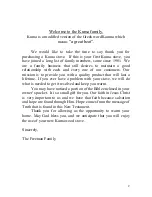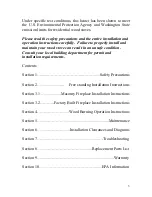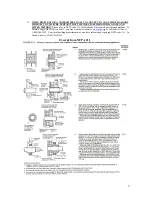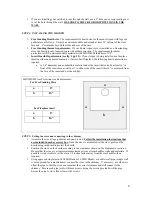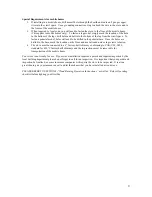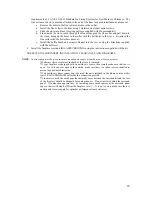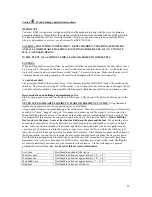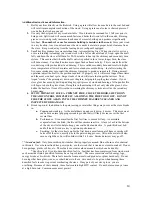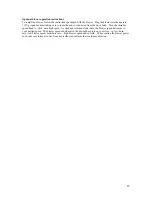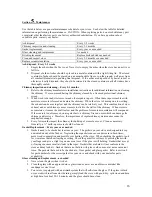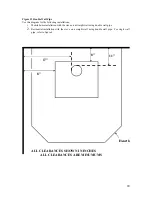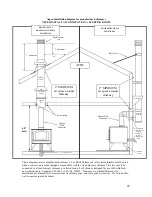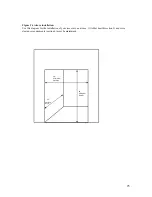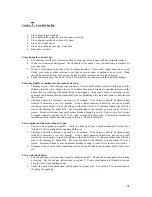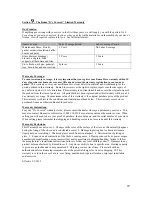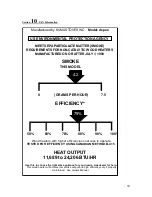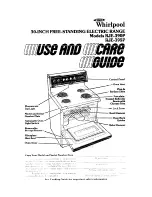
16
Section
5
– Maintenance
Use the table below as a general maintenance schedule for your stove. See below the table for detailed
information on performing the maintenance. CAUTION: When replacing parts, do not substitute any part
or material other than factory parts or a factory authorized substitution. If you have questions about
substitute parts, contact your dealer.
Ash disposal
Every 1-2 weeks
Chimney inspection and cleaning
Every 2-3 months
Gasket replacement
Every year or as needed
Glass cleaning and replacement
As needed
Brick replacement
Replace broken bricks as needed
Clean and inspect stove
Every 2-3 months or as needed.
Replace ceramic insulation
Every year or as needed
Ash disposal – Every 1-2 weeks
1.
Empty the ashes when the fire is out. Never try to empty the ashes when the stove has an active or
full fire.
2.
Disposal of ashes- Ashes should be placed in a metal container with a tight fitting lid. The closed
container of ashes should be placed on a noncombustible floor or on the ground, well away from
all combustible materials, pending final disposal. If the ashes are disposed of by burial in soil or
otherwise locally dispersed, they should be retained in the closed container until all cinders have
thoroughly cooled.
Chimney inspection and cleaning – Every 2-3 months
1.
Refer to the chimney manufacturers installation instructions for additional information on cleaning
the chimney. We recommend having the chimney cleaned by a licensed professional chimney
sweep.
2.
When wood is burned, it releases tar and other organic vapors. When these vapors combine with
moisture, creosote is formed and enters the chimney. When the stove is burning on a low setting,
the exhaust can be moving slow and the chimney can be relatively cool. This combination of slow
exhaust and a cool chimney causes creosote to stick to the walls of the chimney. When creosote
accumulates, it causes the draft to slow and the problem of creosote accumulation will compound.
If the creosote is not removed on a regular basis, a chimney fire can occur which can damage the
chimney and/or stove. Therefore, the importance of regular chimney maintenance cannot be
emphasized enough.
3.
Every few months inspect the chimney for build-up of creosote or soot. Clean as necessary.
Generally, a ¼” build-up or more should be cleaned.
Gasket Replacement – Every year or as needed
1.
Gaskets need to be checked at least once a year. The gaskets on your stove are designed to keep
unwanted air out of the firebox. Neglecting these gaskets can cause a decrease in burn times,
more wood consumption and possible over heating of the stove. When checking the gaskets, look
for wear areas that show fraying or cutting. Check the gasket for softness by pressing them with
your finger and give a slight tug on one area to see if the glue is still holding. Gaskets that are cut
or fraying can cause small air leaks in that spot. Gaskets that are hard will not conform to the
stove and may leak air. Gaskets that are not held in with glue could come out at an inconvenient
time. The gaskets that need to be checked are: Door gasket and glass gasket. Refer to section 8
for part numbers for the correct gasket for your stove and check with your dealer for parts
availability.
Glass cleaning and replacement – as needed
1.
Never clean the glass when it is hot.
2.
Clean the glass with an approved stove glass cleaner, never use an abbrasive material like
sandpaper or steel wool
3.
Your stove is equipped with an airwash system that will self-clean the glass. If the glass is black
or covered with soot from slow burning, simply load the stove with good, dry, split wood and burn
at high burn for about 20- 30 minutes and the glass should burn clean.

